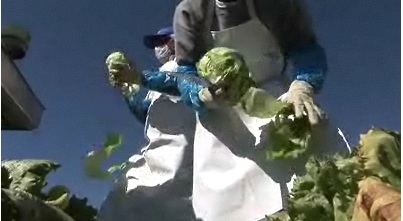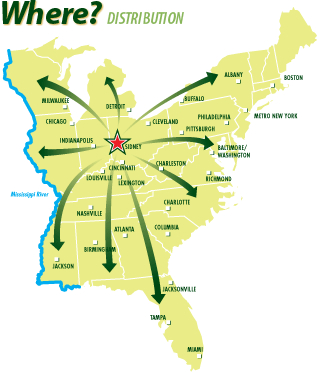There are some new Fresh Express bagged salad commercials running on the television; they don’t mention anything about Salmonella or the many efforts Fresh Express takes .jpeg) to control dangerous pathogens like Salmonella and E. coli in its products.
to control dangerous pathogens like Salmonella and E. coli in its products.
Which is too bad.
There have been many reinterpretations of history regarding fresh produce and microbial food safety. We have argued the tipping point was 1996, involving both the Odwalla E. coli O157:H7 outbreak in unpasteurized juice, coupled with the cyclospora outbreak which was initially and erroneously linked to California strawberries (it was Guatemalan raspberries). This led to the first attempts at comprehensive on-farm food safety programs for fresh produce because, these bugs ain’t going to be washed off; they have to be prevented, as much as possible, from getting on or in fresh produce on the farm.
For the growers of leafy greens, things apparently didn’t tip until the 2006 E. coli O157:H7 outbreak in bagged spinach from California that sickened 200 and killed four.
Ultimately, investigators showed that the E. coli O157:H7 was found on a transitional organic spinach field and was the same serotype as that found in a neighboring grass-fed cow-calf operation. These findings, coupled with the public outcry linked to the outbreak and the media coverage, sparked a myriad of changes and initiatives by the industry, government and others. What may never be answered is, why this outbreak at this time? A decade of evidence existed highlighting problems with fresh produce, warning letters were written, yet little was seemingly accomplished. The real challenge for food safety professionals, is to garner support for safe food practices in the absence of an outbreak, to create a culture that values microbiologically safe food, from farm-to-fork, at all times, and not just in the glare of the media spotlight.
One of the responses out of California was to create the California Leafy Greens Marketing Agreement – after 29 outbreaks, at the time, linked to leafy greens and after years of warning from FDA. The most noticeable achievement since the Agreement has been the containment cone of silence that has descended upon outbreaks involving leafy greens, and an apparent shift in FDA policy that sets epidemiology aside and requires positive samples in unopened product – a ridiculous standard since no one routinely tests for other Shiga-toxin producing E. coli like O145. That was referring to the Freshway Foods E. coli O145 in romaine lettuce outbreak earlier this year that sickened some 50 people near colleges in Michigan, Ohio and New York.
.jpg) These are all confirmed outbreaks. Every day, I receive a couple of messages about people sick here and there, and the public health types have dozens of potential foodborne outbreaks under scrutiny at any one time.
These are all confirmed outbreaks. Every day, I receive a couple of messages about people sick here and there, and the public health types have dozens of potential foodborne outbreaks under scrutiny at any one time.
When to provide public information is a contentious issue: the public has a right to know about outbreaks of foodborne illness and rapid provision of information may prevent additional illnesses, but going too early and too often can be like crying wolf – especially if health types get it wrong and businesses are unduly harmed.
There is a lot of public and private frustration about the lack of guidelines for going public with information about outbreaks. Recent events won’t help.
An e-mail was circulated on May 12, 2010, asking food safety and public health types about a possible salmonella in lettuce outbreak in the Midwest U.S. with links to California.
On Thurs. May 20, lawyer Bill Marler speculated about a lettuce-related Salmonella outbreak in the "upper-Midwest, that appears linked to industry leader, Fresh Express. It is interesting that the Health Department and FDA remain silent on this one too.”
I didn’t publish anything because it was speculation – which I deal with everyday. We have guidelines for what we choose to publish or not. They are available at http://bites.ksu.edu/about-bites.
On May 24, 2010, Fresh Express publicly announced a recall of certain romaine-based ready-to-eat salads with the expired Use-by Dates of May 13th through May 16th and an "S" in the Product Code because they have the potential to be contaminated with Salmonella.
The recall notification is being issued out of an abundance of caution based on an isolated instance in which a single package of Fresh Express Hearts of Romaine Salad with a use by date of May 15 was confirmed positive for Salmonella in a random sample test conducted by the U.S. Food and Drug Administration.
I immediately took to barfblog.com, having been sitting on all this lettuce-related poop for awhile, and asked, when was the sample test conducted by the U.S. Food and Drug Administration because there have been rumors of a positive circulating on the Intertubes? When was the positive confirmed? What strain of Salmonella is involved? Why go public now instead of earlier? How incompetent does the Fresh Express PR person have to be to ignore these questions in the press release? Sounds like the Sponge Bob leafy greens cone of silence.
Shortly thereafter, I got a phone call from Dr. Michael Osterholm, a University of Minnesota expert on infectious diseases and public health and a paid consultant to Fresh Express since 1999.
He didn’t like the post, and didn’t like the picture, which we use for every leafy green outbreak or incident (thank you Christian, former student who created it in my Guelph kitchen).
Osterholm and I bantered back and forth about going public and I stressed, if Fresh Express has a great food safety story to tell, they should tell it.
About 30 minutes later, Osterholm called me back and said, OK, Fresh Express says I can tell you whatever you want to know.
We talked at 6 a.m. central time the next day.
Osterholm repeatedly stressed how committed Fresh Express was to food safety and how that attracted him to consult for the firm. He talked about how the company had ‘boots on the ground’ rather than relying on outsiders for food safety audits, and that the safety culture trumped the legal culture that dominated other firms.
Good for them.
Osterholm stressed that Fresh Express tested irrigation water and product, but did not know if those results would be made public (although they were shared with regulators).
Osterholm told me he was informed a couple of weeks earlier – thereabouts to May 12, 2010 – there were eight people sick Salmonella typhirmirium linked to Fresh Express salad, but they had all consumed it several weeks earlier so there was no public health purpose in going public. The May 24, 2010 Salmonella recall was a completely separate incident. According to Osterholm, FDA types showed up at the Fresh Express office, .jpg) didn’t know the Salmonella species, and yet Fresh Express executed a traceback and recall within hours and that showed how awesome the company was.
didn’t know the Salmonella species, and yet Fresh Express executed a traceback and recall within hours and that showed how awesome the company was.
“Clearly having a salmonella positive in one of your bags is something you don’t want; here was a company that walked the talk, they had a traceback system and within hours could tell everyone about those fields.”
It didn’t say that in the Fresh Express press release, and it’s not up to me to tell their story.
On May 27, 2010, California’s organicgirl produce announced a precautionary recall of 10 oz organicgirl baby spinach with use-by date of May 22.
“organicgirl produce immediately conducted a traceability analysis and an appraisal of its food safety documentation, which were all in compliance. Additionally, organicgirl raw product testing records for the relevant time period did not show the presence of any pathogens.”
Not sure why Fresh Express couldn’t say the same. Maybe they need better PR people.
After talking with Osterholm, I sent an e-mail to the media relations folks at FDA regarding the May 24/10 Fresh Express Salmonella recall, and, after a few days, they responded:
Q. When was the sample collected i.e. when was the bag pulled?
A. May 5, 2010
Q. When was Fresh Express notified of the Salmonella positive?
A. May 21, 2010
Q. What kind of Salmonella was it?
A. S. Anatum
Q. Does FDA review and approve press releases such as the May 24/10 one from Fresh Express?
A. Recall press releases are reviewed at the District primarily.
I then sent a follow-up question, asking why so long between when the sample was pulled – May 5/10 – and the company informed of a positive – May 21/10.
No answer.
FDA, Fresh Express and the leafy greens folks all sorta suck at this communications thing.
FDA is responsive to – who knows, and has no policy for when or how to go public. Oh, they have some things they tell journalists, like this story in the Packer, but it’s full of fudge-factors. I understand there are uncertainties, but, like any good risk assessment, you go public and admit uncertainties rather than trying to act all-knowing.
FDA types also made a big splash in May when their transparency plan was published in the New England Journal of Medicine.
The task force also said the FDA should regularly share basic information about facility inspections it conducts and the result of each inspection. Routinely sharing the information could give the public a clearer understanding of the FDA’s role in protecting public health and would make firms accountable not just to the FDA, but to the larger public.
The information would also give other firms more information about the companies they choose to do business with, the group said. "Market pressures may create incentives for firms to correct violations quickly or prevent violations from occurring in the future."
OMG, FDA is talking about marketing food safety.
But Fresh Express, you’re an industry leader and this year’s winner of the International Association for Food Protection’s Black Pearl award for food safety leadership. Forget government, lead by example. Make your test results public, market food safety at retail so consumers can choose, and if people get sick from your product, you better be the first to tell the public.
A table of leafy green foodborne illness outbreaks is available at:
http://bites.ksu.edu/Outbreaks%20related%20to%20leafy%20greens%201993-2010

 at a bunch of Subway stores in Illinois.
at a bunch of Subway stores in Illinois. Hvittingfoss. Typically, only one to two cases of this type of Salmonella are seen in Illinois per year.
Hvittingfoss. Typically, only one to two cases of this type of Salmonella are seen in Illinois per year..jpg) ready-to-eat salads with the expired Use-by Dates of May 13th through May 16th and an "S" in the Product Code because they have the potential to be contaminated with Salmonella. The recall extends only to products with these Use-by Dates and Product Codes and sold in the following states: Michigan, Minnesota, Wisconsin, Louisiana, Nebraska, Montana, Missouri, Iowa, Kansas, Oklahoma, Arkansas, Nevada, Arizona, California, Colorado, New Mexico, Texas, Oregon, Washington, Alaska, Hawaii, Idaho, Utah, Wyoming, North Dakota, and South Dakota
ready-to-eat salads with the expired Use-by Dates of May 13th through May 16th and an "S" in the Product Code because they have the potential to be contaminated with Salmonella. The recall extends only to products with these Use-by Dates and Product Codes and sold in the following states: Michigan, Minnesota, Wisconsin, Louisiana, Nebraska, Montana, Missouri, Iowa, Kansas, Oklahoma, Arkansas, Nevada, Arizona, California, Colorado, New Mexico, Texas, Oregon, Washington, Alaska, Hawaii, Idaho, Utah, Wyoming, North Dakota, and South Dakota.jpg) What strain of Salmonella is involved? Why go public now instead of earlier? How incompetent does the
What strain of Salmonella is involved? Why go public now instead of earlier? How incompetent does the  Foodie Pollan shows the same characteristics in a
Foodie Pollan shows the same characteristics in a  enterohemorrhagic E. coli (EHEC; Levine et al., 1987; Nataro and Kaper, 1998). Ruminants, especially cattle, constitute a vast reservoir.
enterohemorrhagic E. coli (EHEC; Levine et al., 1987; Nataro and Kaper, 1998). Ruminants, especially cattle, constitute a vast reservoir.
.jpg) journalists find related stories to fill the void.
journalists find related stories to fill the void.(2).jpg) Mike Doyle, a microbiologist who directs the Center for Food Safety at the University of Georgia, told
Mike Doyle, a microbiologist who directs the Center for Food Safety at the University of Georgia, told  "I’ve been avoiding bagged lettuce for years. I’ve been concerned about this for some time."
"I’ve been avoiding bagged lettuce for years. I’ve been concerned about this for some time."
.jpeg) strain of E. coli O145 detected by the New York State Public Health Laboratory, Wadsworth Center, in Albany, in an unopened bag of shredded romaine lettuce distributed by Freshway Foods, matches the outbreak strain of E. coli O145.
strain of E. coli O145 detected by the New York State Public Health Laboratory, Wadsworth Center, in Albany, in an unopened bag of shredded romaine lettuce distributed by Freshway Foods, matches the outbreak strain of E. coli O145..jpg) the same farm in Yuma, Arizona; the company is recalling romaine lettuce with “use-by” dates of May 9 and May 10. The recalled romaine lettuce distributed by Vaughan Foods was sold to restaurants and food service facilities and were not available for purchase at retail by consumers.
the same farm in Yuma, Arizona; the company is recalling romaine lettuce with “use-by” dates of May 9 and May 10. The recalled romaine lettuce distributed by Vaughan Foods was sold to restaurants and food service facilities and were not available for purchase at retail by consumers. Freshway Foods recalled romaine lettuce products
Freshway Foods recalled romaine lettuce products.jpg) In the wake of the E. coli O145 outbreak in romaine lettuce, a laboratory in Ohio started testing bags of romaine and found another E. coli which lead to a very private recall on Friday.
In the wake of the E. coli O145 outbreak in romaine lettuce, a laboratory in Ohio started testing bags of romaine and found another E. coli which lead to a very private recall on Friday. Bob LaMendola of the Florida Sun Sentinel writes
Bob LaMendola of the Florida Sun Sentinel writes to document food safety practices at some Manhattan (Kansas) salad bars. Reggie describes himself as new to food safety reporting but a vigorous eater. Currently a Kansas State University student living in Wichita, Kansas, he hopes to one day graduate and pay off his student loans before death – dp)
to document food safety practices at some Manhattan (Kansas) salad bars. Reggie describes himself as new to food safety reporting but a vigorous eater. Currently a Kansas State University student living in Wichita, Kansas, he hopes to one day graduate and pay off his student loans before death – dp).jpg) themselves at the salad bar. These included: spilling food around containers; dipping their fingers into salad dressings for a sample lick; eating from their plates while waiting in the serving line; and ducking their heads underneath the sneeze guard (clear plastic roof) for better access to the food.
themselves at the salad bar. These included: spilling food around containers; dipping their fingers into salad dressings for a sample lick; eating from their plates while waiting in the serving line; and ducking their heads underneath the sneeze guard (clear plastic roof) for better access to the food..jpg) According to the U.S. Food and Drug Administration (FDA) perishable fresh fruits and vegetables can be best maintained by storing in a clean refrigerator at a temperature of 40° F or below. Temperature is also an important component to salad bar safety. According to the FDA’s food safety website (http://foodsafety.gov/) bacteria grow most rapidly in the range of temperatures between 40 ° and 140 °F, doubling in number in as little as 20 minutes. This range of temperatures is often called the "Danger Zone."
According to the U.S. Food and Drug Administration (FDA) perishable fresh fruits and vegetables can be best maintained by storing in a clean refrigerator at a temperature of 40° F or below. Temperature is also an important component to salad bar safety. According to the FDA’s food safety website (http://foodsafety.gov/) bacteria grow most rapidly in the range of temperatures between 40 ° and 140 °F, doubling in number in as little as 20 minutes. This range of temperatures is often called the "Danger Zone." hairnets release body heat, but are not for use in direct food contact areas. When asked, Richardson said she believed her hairnet was mesh, but wasn’t sure.
hairnets release body heat, but are not for use in direct food contact areas. When asked, Richardson said she believed her hairnet was mesh, but wasn’t sure.
.jpg) Ohio, Michigan and New York
Ohio, Michigan and New York  salad bars and delis for Kroger, Giant Eagle, Ingles Markets, and Marsh stores in the states listed.
salad bars and delis for Kroger, Giant Eagle, Ingles Markets, and Marsh stores in the states listed..jpg) and three with a potentially life threatening complication called hemolytic uremic syndrome (HUS).
and three with a potentially life threatening complication called hemolytic uremic syndrome (HUS).  Cross-contamination was unlikely in this scenario because students in different states got sick at the same time, and investigators said early on that beef was an unlikely vehicle.
Cross-contamination was unlikely in this scenario because students in different states got sick at the same time, and investigators said early on that beef was an unlikely vehicle. The recall comes after FDA informed Freshway Foods the afternoon of Wednesday, May 5 that a previously unopened product sample in a New York state laboratory tested positive for the bacteria. Freshway Foods traced the entire lot of romaine products and is advising customers to cease use and distribution of it immediately. This recall may be linked to an outbreak investigation in New York, Michigan, and Ohio.
The recall comes after FDA informed Freshway Foods the afternoon of Wednesday, May 5 that a previously unopened product sample in a New York state laboratory tested positive for the bacteria. Freshway Foods traced the entire lot of romaine products and is advising customers to cease use and distribution of it immediately. This recall may be linked to an outbreak investigation in New York, Michigan, and Ohio.